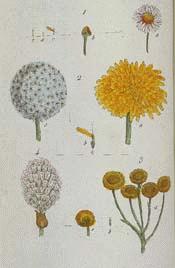
Botanical.com Home Page

|
Daisy, Common
(Bellis perennis)
Click on graphic for larger image
|
Daisy, Common
Botanical: Bellis perennis (LINN.)
Family: N.O. Compositae
---Synonyms---Bruisewort. (Scotch) Bairnwort. (Welsh) Llygad y Dydd (Eye of the Day).
---Parts Used---Root, leaves.
The Common Daisy, which flowers from the earliest days of spring till late in the autumn, and covers the ground with its flat leaves so closely that nothing can grow beneath them, needs no detailed description.
It had once, in common with the Ox-Eye Daisy, a great reputation as a cure for fresh wounds, used as an ointment applied externally, and against inflammatory disorders of the liver, taken internally in the form of a distilled water of the plant.
The flowers and leaves are found to afford a certain amount of oil and ammoniacal salts.
Gerard mentions the Daisy, under the name of 'Bruisewort,' as an unfailing remedy in 'all kinds of paines and aches,' besides curing fevers, inflammation of the liver and 'alle the inwarde parts.'
In 1771 Dr. Hill said that an infusion of the leaves was 'excellent against Hectic Fevers.' The Daisy was an ingredient of an ointment much used in the fourteenth century for wounds, gout and fevers.
A strong decoction of the roots has been recommended as an excellent medicine in scorbutic complaints, it being stated, however, that the use of it must be continued for a considerable length of time before its effects will appear.
The taste of the leaves is somewhat acrid, notwithstanding which it has been used in some countries as a pot-herb. On account of the acrid juice contained in the leaves, no cattle will touch it, nor insects attack it.
The roots, too, have a penetrating pungency, containing some tannic acid, and there was once a popular superstition (to which Bacon refers) that if they be boiled in milk and the liquid given to puppies, the animals will grow no bigger.
- According to some old writers, the generic name is derived from the Latin bellus (pretty or charming), though others say its name is from a dryad named Belidis. The common name is a corruption of the old English name 'day's-eye,' and is used by Chaucer in that sense:
- 'Well by reason men it call maie
- The Daisie, or else the Eye of the Daie.'
In Scotland it is the 'Bairnwort,' testifying to the joy of children in gathering it for daisy-chains.
There is a common proverb associated with the flower and its abundance in spring and early summer: 'When you can put your foot on seven daisies summer is come.'
Common Name Index
A MODERN HERBAL Home Page
Bear in mind "A Modern Herbal" was written with the conventional wisdom of the early 1900's. This should be taken into account as some of the information may now be considered inaccurate, or not in accordance with modern medicine.
© Copyright Protected 1995-2024 Botanical.com
|

